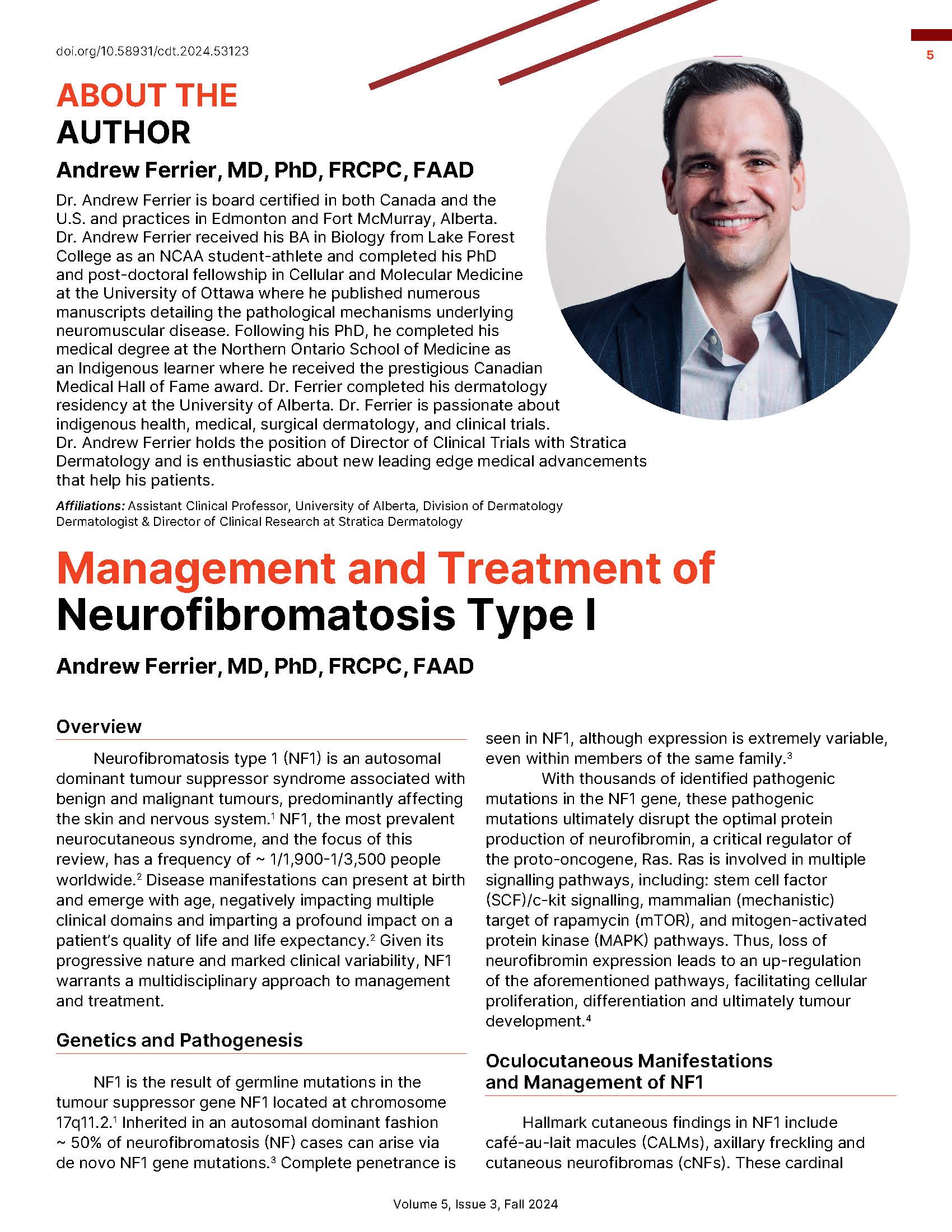Management and Treatment of Neurofibromatosis Type I
DOI:
https://doi.org/10.58931/cdt.2024.53123Abstract
Neurofibromatosis type 1 (NF1) is an autosomal dominant tumour suppressor syndrome associated with benign and malignant tumours, predominantly affecting the skin and nervous system. NF1, the most prevalent neurocutaneous syndrome, and the focus of this review, has a frequency of ~ 1/1,900-1/3,500 people worldwide. Disease manifestations can present at birth and emerge with age, negatively impacting multiple clinical domains and imparting a profound impact on a patient’s quality of life and life expectancy. Given its progressive nature and marked clinical variability, NF1 warrants a multidisciplinary approach to management and treatment.
References
Wallace MR, Marchuk DA, Andersen LB, et al. Type 1 neurofibromatosis gene: identification of a large transcript disrupted in three NF1 patients. Science. 1990;249:181-6.
Uusitalo E, Leppavirta J, Koffert A, et al. Incidence and mortality of neurofibromatosis: a total population study in Finland. J Invest Dermatol. 2015;135:904-6.
Easton DF, Ponder MA, Huson SM, et al. An analysis of variation in expression of neurofibromatosis (NF) type 1 (NF1): evidence for modifying genes. Am J Hum Genet. 1993 Aug;53(2):305-13.
Gutmann DH, Ferner RE, Listernick RH, et al. Neurofibromatosis type 1. Nat Rev Dis Primers. 2017 Feb 23;3:17004.
Legius E, Messiaen L, Wolkenstein P, et al; International Consensus Group on Neurofibromatosis Diagnostic Criteria (I-NF-DC); Huson SM, Evans DG, Plotkin SR. Revised diagnostic criteria for neurofibromatosis type 1 and Legius syndrome: an international consensus recommendation. Genet Med. 2021 Aug;23(8):1506-13.
Nunley KS, Gao F, Albers AC, et al. Predictive value of cafe au lait macules at initial consultation in the diagnosis of neurofibromatosis type 1. Arch Dermatol. 2009;145(8):883-7.
DeBella K, Szudek J, Friedman JM. Use of the national institutes of health criteria for diagnosis of neurofibromatosis 1 in children. Pediatrics. 2000 Mar;105(3 Pt 1):608-14.
Korf BR. Diagnostic outcome in children with multiple café au lait spots. Pediatrics. 1992 Dec;90(6):924-7.
Huson SM, Harper PS, Compston DA. Von Recklinghausen neurofibromatosis. A clinical and population study in south-east Wales. Brain. 1988;111(Pt 6):1355-81.
Miller DT, Freedenberg D, Schorry E, et al; Council on Genetics; American College of Medical Genetics and Genomics. Health Supervision for Children With Neurofibromatosis Type 1. Pediatrics. 2019 May;143(5):e20190660.
Nguyen R, Dombi E, Widemann BC, et al. Growth dynamics of plexiform neurofibromas: a retrospective cohort study of 201 patients with neurofibromatosis 1. Orphanet J Rare Dis. 2012 Oct 4;7:75.
Stewart DR, Korf BR, Nathanson KL, et al. Care of adults with neurofibromatosis type 1: a clinical practice resource of the American College of Medical Genetics and Genomics (ACMG). Genet Med. 2018 Jul;20(7):671-82.
Ferner RE, Gutmann DH. International consensus statement on malignant peripheral nerve sheath tumors in neurofibromatosis. Cancer Res. 2002 Mar 1;62(5):1573-7.
Pannu AK, Sharma N. Neurofibromatosis type 1 and disseminated malignant peripheral nerve sheath tumor. QJM. 2017 Sep 1;110(9):583-4.
Lewis RA, Gerson LP, Axelson KA, et al. von Recklinghausen neurofibromatosis. II. Incidence of optic gliomata. Ophthalmology. 1984 Aug;91(8):929-35.
Fisher MJ, Loguidice M, Gutmann DH, et al. Visual outcomes in children with neurofibromatosis type 1-associated optic pathway glioma following chemotherapy: a multicenter retrospective analysis. Neuro Oncol. 2012 Jun;14(6):790-7.
Lorenzo J, Barton B, Arnold SS, et al. Developmental trajectories of young children with neurofibromatosis type 1: a longitudinal study from 21 to 40 months of age. J Pediatr. 2015 Apr;166(4):1006-12.e1.
Pinna V, Daniele P, Calcagni G, et al. Prevalence, type, and molecular spectrum of NF1 mutations in patients with neurofibromatosis Type 1 and congenital heart disease. Genes (Basel). 2019 Sep 4;10(9):675.
Walker L, Thompson D, Easton D, et al. A prospective study of neurofibromatosis type 1 cancer incidence in the UK. Br J Cancer. 2006 Jul 17;95(2):233-8.
Evans DGR, Kallionpää RA, Clementi M, et al. Breast cancer in neurofibromatosis 1: survival and risk of contralateral breast cancer in a five country cohort study. Genet Med. 2020 Feb;22(2):398-406. Erratum in: Genet Med. 2019 Oct 8; PMID: 31495828; PMCID: PMC7000349.


